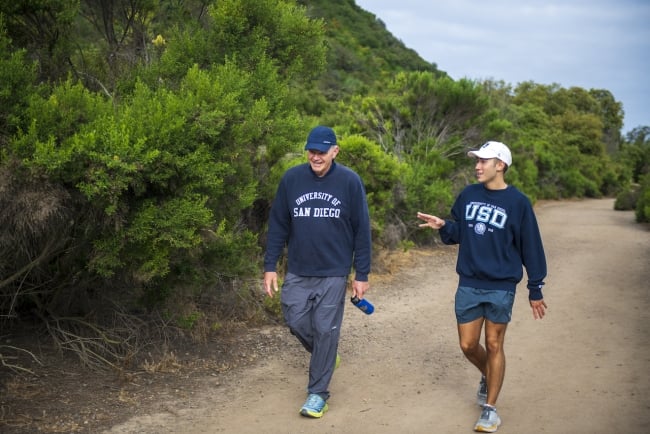You have /5 articles left.
Sign up for a free account or log in.

University of San Diego President James T. Harris walks In Tecolote Canyon with student Robert Justice.
University of San Diego
“What happens if I don’t get into law school?” This is the question a student asks me as we walk together on an overcast March morning. This is not the reason she originally said she wanted to talk to me when we scheduled our walk, but it is clearly what is on her mind. She is seeking reassurance from me that things are going to work out, whether she gets into law school or not.
After walks like this, I often think of Pope Francis’s advice for those looking to be authentic leaders capable of living, loving, laughing and crying with the people they serve: “A shepherd should smell of the sheep, grounded in the situation of their flock.” The idea of being grounded in the situation of the people whom a leader serves is an appropriate metaphor for college and university presidents to consider as we take on the demands of leading complex institutions in a highly volatile environment.
The students we serve today are different from previous generations, and that requires all campus leaders to reconsider how we engage and interact with them. Gen Z students have been described as personally ambitious and politically progressive, and as consumers who are looking for an “authentic” experience while enrolled in college. Such experiences can be found in high-impact practices like undergraduate research, learning communities, community engagement, diverse and global learning opportunities, and capstone projects. But in addition to what they are expecting from their college experience, Gen Z students are demanding that college leaders, especially presidents, be personally responsive when issues arise—accessible and approachable rather than “performative” as leaders. In other words, they want to know that the leader of their campus is grounded in the “experience of the flock”—namely, students—in some basic way.
After weeks of dealing with some tough institutional issues and feeling disconnected from the joy of working on a campus, I, too, am in need of reassurance. While not truly realizing it when we began our walk, I now see that I want to feel that I’m still having a positive impact on the lives of the students I serve. By the end of our walk, we both feel more grounded and prepared to take on our days.
It is well known that Gen Z students are the first generation to be digital natives. Like many of my presidential colleagues across the country, I have tried to meet our students on their own turf by posting photos and messages on social media. That has given me some credibility, but no matter how well I use social media, I have discovered that I must not confuse such university communication tools with authentic interaction. Our students are seeking more from me as president.
Connecting Authentically
For the past 29 years, I have served as the president of three distinctly different institutions. At each institution I have attempted to be present at key student events throughout the academic year—athletic competitions, student government–sponsored activities and other highly visible student programs. But it is one new practice that I instituted when I arrived at the University of San Diego that has had the greatest impact of them all: my morning walks in the nearby canyon with students.
Early in my tenure here, I gained a reputation for being someone who enjoys being outside in nature. I would join our outdoor adventures club for kayaking trips in the ocean or hiking expeditions in the canyons near our campus. As someone who enjoys being active, I have found that if I don’t schedule my morning routine of walking as part of my workday, my calendar will quickly be filled with other meetings.
Once I established that routine, I decided to open up a few mornings a week to anyone who wished to join me. At first, only a few students took me up on my offer. But now it is unusual to go a week without a student—or even a small group of students—signing up to join me.
The routine I have established is a three-mile loop that includes walking in a canyon adjacent to the campus. And in the approximately 45 minutes that we spend together, I have found that students tend to let their guards down and share information about themselves and their experience at the university that I would normally not have access to if we were meeting in a more formal setting. I, too, feel more at ease and comfortable bringing my authentic self to the conversation, and because of those interactions, I feel I have become more deeply attuned, or grounded in the situation of my flock.
It only took a few walks to help spread the word that I was approachable and attempting to authentically engage in dialogue with students. Through these experiences, I have grown as a leader and learned that students often have great insights into complex problems that my senior team and I would have never considered when making campus decisions. It has also allowed me to return to what I have always loved about working in higher education: mentoring young people who are looking to speak with an adult about their hopes and dreams for the future.
Last summer I even took my walks internationally when I hiked the Camino de Santiago in Spain alongside faculty, alumni and students from the university. During our time together, I discovered that many people have a need to authentically connect with others, and by creating this opportunity, we all benefited deeply from the experience. An added benefit is that we now feel connected in a way we didn’t predict before our journey began, and that has led to some unexpected outcomes for us all, like the creation of an intergenerational alumni and student group that has become more engaged in campus activities.
Few jobs in society today are as demanding as that of a college or university president. The many competing responsibilities of such a role often require the leader to be off campus or engaged in back-to-back meetings that can drain their energy. Yet we can’t lose sight of why we wanted to be a president in the first place: to have a positive impact on the lives of the students we serve.
One of the benefits of having been a president for so long is that I am asked to advise aspiring college leaders about how to succeed in the top position. When asked, I start by telling them to be the living embodiment of the mission of the institution they serve. The best way I personally have found to do that is to discover an authentic way to engage with students and other people in the campus community. For me, taking a morning walk with a student does just that: it helps to ground me and opens my heart to listen more closely. My walk in the canyon also helps me accomplish the second piece of advice I always offer others: to be like the shepherd and smell of the sheep.








